-

新人教版高中英语必修3Unit 2 Morals and virtues教学设计一
(2) students are divided into groups according to the requirements of activity 3. Each student shares a story of personal experience or hearing-witnessing kindness, and then selects the most touching story in the group and shares it with the whole class. Before the students share the story, the teacher can instruct them to use the words and sentence patterns in the box to express. For example, the words in the box can be classified:Time order: first of all, then, after that, later, finally logical relationship :so, however, although, butTeachers can also appropriately add some transitional language to enrich students' expression:Afterwards, afterwards, at last, in the end, eventuallySpatial order: next to, far from, on the left, in front ofOtherwise, nevertheless, as a result, therefore, furthermore, in addition, as well asSummary: in a word, in short, on the whole, to sum up, in briefStep 8 Homework1. Understand the definition of "moral dilemma" and establish a correct moral view;2. Accumulate vocabulary about attitudes and emotions in listening texts and use them to express your own views;3. Complete relevant exercises in the guide plan.1、通过本节内容学习,学生能否理解理解“道德困境”的定义;2、通过本节内容学习,学生能否通过说话人所表达的内容、说话的语气、语调等来判断其态度和情绪;3、通过本节内容学习,学生能否针对具体的道德困境发表自己的看法和见解,能否掌握听力理训练中的听力策略。
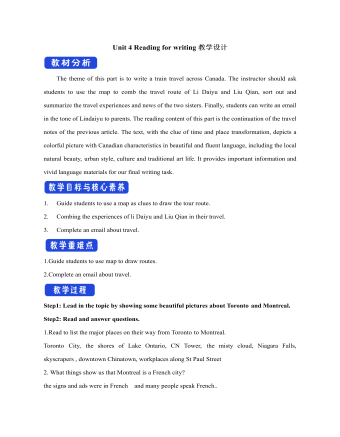
新人教版高中英语选修2Unit 4 Reading for writing教学设计
假定你是英国的Jack,打算来中国旅行,请你给你的中国笔友李华写一封信,要点如下:1.你的旅行计划:北京→泰山→杭州;2.征求建议并询问他是否愿意充当你的导游。注意:1.词数80左右(开头和结尾已给出,不计入总词数);2.可以适当增加细节,以使行文连贯。参考词汇:故宫 the Forbidden City;泰山 Mount TaiDear Li Hua,I'm glad to tell you that 'm going to visit China.First,I am planning to visit Beijing,the capitalof China,where I am looking forward to enjoying the Great Wall,the Forbidden City and somebeautiful parks.Then I intend to go to visit Mount Tai in Shandong Province.I've heard that it is one ofthe most famous mountains in China and I can't wait to enjoy the amazing sunrise there.After that,I amalso going to Hangzhou.It is said that it is a beautiful modern city with breathtaking natural sights,among which the West Lake is a well- known tourist attraction.What do you think of my travel plan? Will you act as my guide? Hope to hear from you soon.
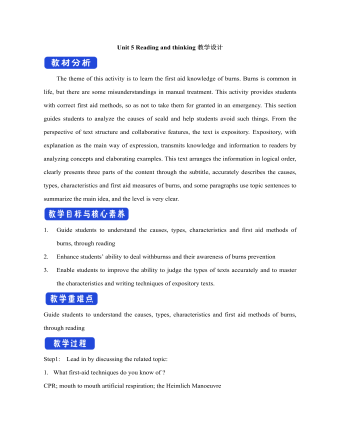
新人教版高中英语选修2Unit 5 Reading and thinking教学设计
The theme of this activity is to learn the first aid knowledge of burns. Burns is common in life, but there are some misunderstandings in manual treatment. This activity provides students with correct first aid methods, so as not to take them for granted in an emergency. This section guides students to analyze the causes of scald and help students avoid such things. From the perspective of text structure and collaborative features, the text is expository. Expository, with explanation as the main way of expression, transmits knowledge and information to readers by analyzing concepts and elaborating examples. This text arranges the information in logical order, clearly presents three parts of the content through the subtitle, accurately describes the causes, types, characteristics and first aid measures of burns, and some paragraphs use topic sentences to summarize the main idea, and the level is very clear.1. Guide students to understand the causes, types, characteristics and first aid methods of burns, through reading2. Enhance students’ ability to deal withburnss and their awareness of burns prevention3. Enable students to improve the ability to judge the types of texts accurately and to master the characteristics and writing techniques of expository texts.Guide students to understand the causes, types, characteristics and first aid methods of burns, through readingStep1: Lead in by discussing the related topic:1. What first-aid techniques do you know of ?CPR; mouth to mouth artificial respiration; the Heimlich Manoeuvre
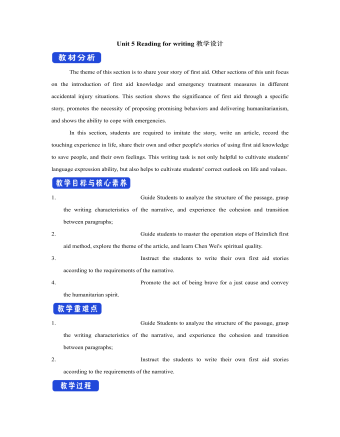
新人教版高中英语选修2Unit 5 Reading for writing教学设计
你校英语报计划出版一期急救常识专刊,现面向全校学生公开征集稿件,你有意参加。请你根据下面提示内容,用英语写一篇短文,介绍在车祸现场对伤者进行急救的方法和步骤。1.确保现场的安全;2.询问伤者,确保其呼吸正常;3.检查伤口,如流血则应采取止血措施;4.如需急救,确保其处于康复位置。注意:1.词数80左右;2.可以适当增加细节,以使行文连贯。参考词汇:康复位置 recovery positionAs we all know, having a knowledge of first aid can make a great difference in our daily life. If a traffic accident happens and someone is injured, the following steps can be used to treat the injured.In the first place, we should make sure that the accident scene is safe so that we won’t get hurt. We should ask the injured person if he is OK, and see if he is breathing. What’s more, we should check for cuts and wounds. If he is bleeding badly, it is vital that we should try to stop the bleeding by applying pressure to the injury. This is because if a person loses too much blood, he may die. If necessary, take the injured person to the hospital as soon as possible.Do remember: when giving first aid, please be sure to place the person in a recovery position.
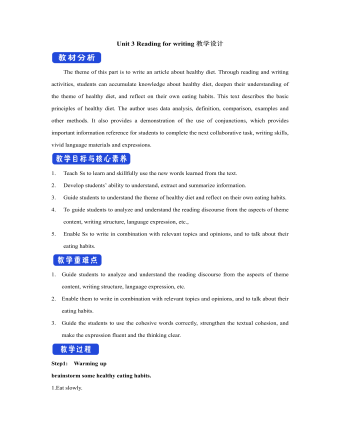
新人教版高中英语选修2Unit 3 Reading for writing教学设计
The theme of this part is to write an article about healthy diet. Through reading and writing activities, students can accumulate knowledge about healthy diet, deepen their understanding of the theme of healthy diet, and reflect on their own eating habits. This text describes the basic principles of healthy diet. The author uses data analysis, definition, comparison, examples and other methods. It also provides a demonstration of the use of conjunctions, which provides important information reference for students to complete the next collaborative task, writing skills, vivid language materials and expressions.1. Teach Ss to learn and skillfully use the new words learned from the text.2. Develop students’ ability to understand, extract and summarize information.3. Guide students to understand the theme of healthy diet and reflect on their own eating habits.4. To guide students to analyze and understand the reading discourse from the aspects of theme content, writing structure, language expression, etc., 5. Enable Ss to write in combination with relevant topics and opinions, and to talk about their eating habits.1. Guide students to analyze and understand the reading discourse from the aspects of theme content, writing structure, language expression, etc.2. Enable them to write in combination with relevant topics and opinions, and to talk about their eating habits.3. Guide the students to use the cohesive words correctly, strengthen the textual cohesion, and make the expression fluent and the thinking clear.Step1: Warming upbrainstorm some healthy eating habits.1.Eat slowly.2.Don’t eat too much fat or sugar.3.Eat healthy food.4.Have a balanced diet.Step2: Read the passage and then sum up the main idea of each paragraph.
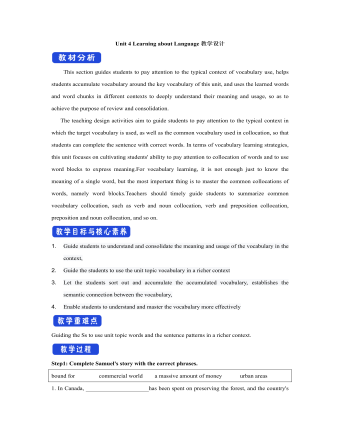
新人教版高中英语选修2Unit 4 Learning about Language教学设计
This section guides students to pay attention to the typical context of vocabulary use, helps students accumulate vocabulary around the key vocabulary of this unit, and uses the learned words and word chunks in different contexts to deeply understand their meaning and usage, so as to achieve the purpose of review and consolidation.The teaching design activities aim to guide students to pay attention to the typical context in which the target vocabulary is used, as well as the common vocabulary used in collocation, so that students can complete the sentence with correct words. In terms of vocabulary learning strategies, this unit focuses on cultivating students' ability to pay attention to collocation of words and to use word blocks to express meaning.For vocabulary learning, it is not enough just to know the meaning of a single word, but the most important thing is to master the common collocations of words, namely word blocks.Teachers should timely guide students to summarize common vocabulary collocation, such as verb and noun collocation, verb and preposition collocation, preposition and noun collocation, and so on.1. Guide students to understand and consolidate the meaning and usage of the vocabulary in the context, 2. Guide the students to use the unit topic vocabulary in a richer context3. Let the students sort out and accumulate the accumulated vocabulary, establishes the semantic connection between the vocabulary,4. Enable students to understand and master the vocabulary more effectivelyGuiding the Ss to use unit topic words and the sentence patterns in a richer context.

新人教版高中英语选修2Unit 4 Using langauge-Listening教学设计
The theme of the listening section is " talking about scenery and culture along a journey."The part is designed to further lead the students to understand Canadian natural geography and social environment, and integrated into the cultural contrast by mentioning the long train journey from Beijing to Moscow routes. On this basis, the part activates students related travel experience, lets the student serial dialogue, guides the student to explore further the pleasure and meaning of the long journey, and Chinese and foreign cultural comparison.The part also provides a framework for the continuation of the dialogue, which is designed to provide a framework for students to successfully complete their oral expressions, and to incorporate an important trading strategy to end the dialogue naturally.1. Help students to understand and master some common English idioms in the context, and experience the expression effect of English idioms.2. Guide the students to understand the identity of different people in the listening context, and finish the dialogue according to their own experience.3. Instruct the students to use appropriate language to express surprise and curiosity about space and place in the dialogue, and master the oral strategy of ending the dialogue naturally.1. Instruct students to grasp the key information and important details of the dialogue.2. Instruct students to conduct a similar talk on the relevant topic.

新人教版高中英语选修2Unit 5 Learning about Language教学设计
The purpose of this section of vocabulary exercises is to consolidate the key words in the first part of the reading text, let the students write the words according to the English definition, and focus on the detection of the meaning and spelling of the new words. The teaching design includes use English definition to explain words, which is conducive to improving students' interest in vocabulary learning, cultivating their sense of English language and thinking in English, and making students willing to use this method to better grasp the meaning of words, expand their vocabulary, and improve their ability of vocabulary application. Besides, the design offers more context including sentences and short passage for students to practice words flexibly.1. Guide students to understand and consolidate the meaning and usage of the vocabulary in the context, 2. Guide the students to use the unit topic vocabulary in a richer context3. Let the students sort out and accumulate the accumulated vocabulary, establishes the semantic connection between the vocabulary,4. Enable students to understand and master the vocabulary more effectivelyGuiding the Ss to use unit topic words and the sentence patterns in a richer context.Step1: Read the passage about chemical burns and fill in the blanks with the correct forms of the words in the box.

新人教版高中英语选修2Unit 5 Using langauge-Listening教学设计
The theme of this section is to learn how to make emergency calls. Students should learn how to make emergency calls not only in China, but also in foreign countries in English, so that they can be prepared for future situations outside the home.The emergency telephone number is a vital hotline, which should be the most clear, rapid and effective communication with the acute operator.This section helps students to understand the emergency calls in some countries and the precautions for making emergency calls. Through the study of this section, students can accumulate common expressions and sentence patterns in this context. 1.Help students accumulate emergency telephone numbers in different countries and learn more about first aid2.Guide the students to understand the contents and instructions of the telephone, grasp the characteristics of the emergency telephone and the requirements of the emergency telephone.3.Guide students to understand the first aid instructions of the operators.4.Enable Ss to make simulated emergency calls with their partners in the language they have learned1. Instruct students to grasp the key information and important details of the dialogue.2. Instruct students to conduct a similar talk on the relevant topic.Step1:Look and discuss:Match the pictures below to the medical emergencies, and then discuss the questions in groups.

中班科学活动:《舞台灯光师》课件教案
2、 能表达自己的发现及疑问,和同伴互相合作玩游戏 3、 培养幼儿对自然科学的兴趣活动准备: 1、 红、黄、蓝、绿的玻璃纸、各色布、皱纹纸若干,大小能覆盖手电筒口 2、 手电筒幼儿人手一个 3、 一段节奏强烈的音乐活动过程: 一、引发幼儿对活动的兴趣 师:“小朋友,今天我要和你们玩一个很好玩的你们从没玩过的游戏,好吗?” 教师打开手电筒,将光照射到活动室墙面上, 师:“小朋友,你们看到了什么?” 幼儿自由讲述 师:“现在请你们猜一猜,如果在手电筒前面蒙上一块红布,会怎么样?”幼儿自由讲述
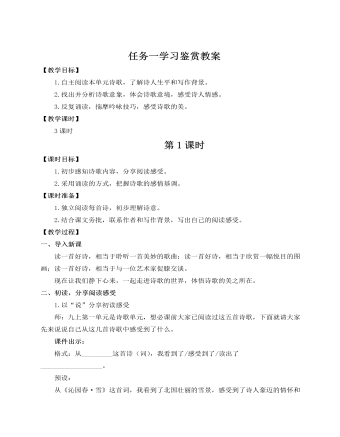
人教部编版语文九年级上册任务一学习鉴赏教案
审美鉴赏与创造——诗歌意象“诗是无声画”,诗要用形象说话。一般说来,诗歌写作是由“灵感—寻象—寻言”这三个阶段构成的。获得灵感,就是获得一种诗美体验;获得诗美体验之后,就要将诗美体验转化为诗歌意象。诗歌意象创作要注意以下几个方面:1.象征手法的运用。象征多用具体生动的形象来暗示某种生活、情绪和哲理,可以将抽象的事物变得具体可感。2.要善于将抽象的感情形象化。诗歌创作中,或是即事抒情,或是融情于景,或是托物言志,要尽力将情感形象化,避免单纯地抒情。3.意象的组合。意象组合是用一个接一个的意象,按照一定的美学原则把它组合起来,形成一幅幅跳跃的画面,使它们产生对比、衬托、联想、暗示等作用,让读者通过一系列的意象组合去揣摩和领悟作者的意图。
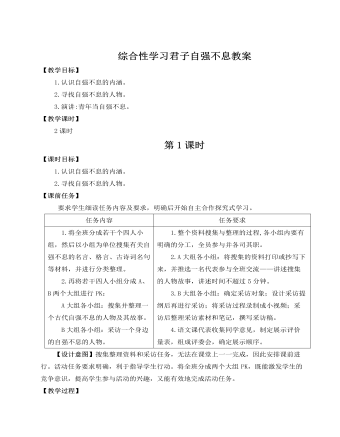
人教部编版语文九年级上册综合性学习君子自强不息教案
正如朱敏先生所说的那样,他之所以能打败那些强大的对手是因为自己的一股韧劲。自强的心鞭策我们勇往直前,失败算什么,困难算什么,自强者永不止步。生命可以大写,也可以小写,还可以简写。小写的生命是灵魂上的侏儒,简写的生命是灵魂上的庸碌者,唯有自强者是天地间用正气、智慧写出的一个气宇轩昂的大写的人。独立是它的一撇,拼搏是它的一捺,两者缺少其一,都不能称之为一个完整意义上的“人”。自强是生命之杯中的琼浆玉液,他让每一个举杯者赢得了鲜花和掌声,收获了成功和喜悦,体味到了人生的真实与厚重!在我们的人生旅程中,每个人或多或少会遇到这样那样的挫折。也许是一次考试的失利,也许是一场突如其来的意外,没有谁能够保证他的一生总是平平安安、一帆风顺。面对挫折我们不应该失意、彷徨,因自己陷入人生灰色的圈子而倍感焦虑、难以自拔。我们要学会自强,因为只有学会自强,我们才敢正视所有问题;只有学会自强,才会有勇气去战胜一道道难题。
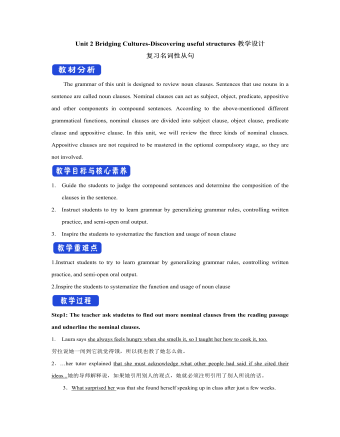
新人教版高中英语选修2Unit 2 Bridging Cultures-Discovering useful structures教学设计
The grammar of this unit is designed to review noun clauses. Sentences that use nouns in a sentence are called noun clauses. Nominal clauses can act as subject, object, predicate, appositive and other components in compound sentences. According to the above-mentioned different grammatical functions, nominal clauses are divided into subject clause, object clause, predicate clause and appositive clause. In this unit, we will review the three kinds of nominal clauses. Appositive clauses are not required to be mastered in the optional compulsory stage, so they are not involved.1. Guide the students to judge the compound sentences and determine the composition of the clauses in the sentence.2. Instruct students to try to learn grammar by generalizing grammar rules, controlling written practice, and semi-open oral output.3. Inspire the students to systematize the function and usage of noun clause1.Instruct students to try to learn grammar by generalizing grammar rules, controlling written practice, and semi-open oral output.2.Inspire the students to systematize the function and usage of noun clauseStep1: The teacher ask studetns to find out more nominal clauses from the reading passage and udnerline the nominal clauses.
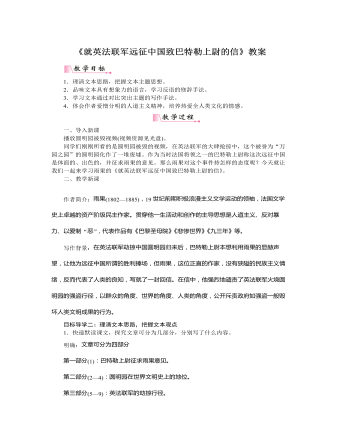
部编版语文九年级上册《就英法联军远征中国致巴特勒上尉的信》教案
3.作者是如何表达出自己的观点的?明确:作者首先以瑰丽的语言盛赞圆明园在人类文明中的地位,其后,又以比喻及反讽的修辞,将英法联军劫掠圆明园的罪行揭露而出,两者形成鲜明的对比,从而引出谴责英法联军远征中国行为的观点。目标导学三:了解作者心中的圆明园及英法联军的强盗行径1.作者是如何描述他心目中的圆明园的?明确:圆明园是幻想的某种规模巨大的典范,一座言语无法形容的建筑,某种恍若月宫的建筑。作者用大理石,玉石,青铜,瓷器,雪松,宝石,绸缎,神殿,后宫,城楼,神像,异兽,琉璃,珐琅,黄金,脂粉,一座座花园,一方方水池,一眼眼喷泉,成群的天鹅、朱鹭和孔雀等无数华贵的象征,铺就了一张华贵的想象画面,构成他心中的圆明园。正如他所说“总而言之,请你假设人类幻想的某种令人眼花缭乱的洞府,其外观是神庙,是宫殿,那就是这座园林”。

部编版语文九年级上册《中国人失掉自信力了吗》教案
一、导入新课我们已经学过鲁迅先生的不少文章,学过他的小说,看他用无数生动的形象表达他在时代里的“呐喊”与“彷徨”;学过他的散文,与他一同在失落中“朝花夕拾”,安静地回忆过往。今天,我们将学习鲁迅先生的一篇杂文,看他是如何作为民族斗士,将手中的笔,变成抨击敌人的枪。二、教学新课目标导学一:学习驳论,理清思路1.初读课文,找出对方的错误观点,并说说作者是怎样引出这一观点的。明确:对方的错误观点是“中国人失掉自信力了”。开篇以似乎确凿的事实为据,用一句话指出了三个阶段中“中国人”表现出来的三种不同的态度:盲目骄傲,夜郎自大;盲目崇拜,借助外援;今不如昔,祈求鬼神。即由自夸到崇洋,到自欺欺人、虚无渺茫的态度变化。因此有人“慨叹”:“中国人失掉自信力了。”这是论敌的论点。
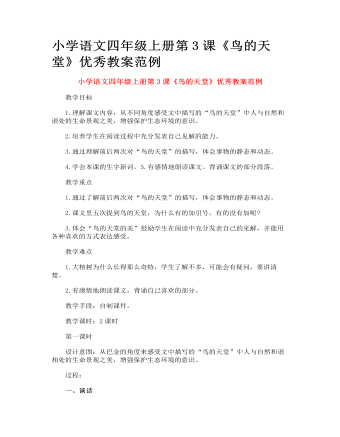
小学语文四年级上册第3课《鸟的天堂》优秀教案范例
首先我们进入到真正的鸟的天堂,也就是你们的天堂去看一下: 1.出示课件(12-13自然段的内容) 2.自由读这一部分,这一部分写出了“鸟的天堂”什么特点?(活泼可爱、鸟多)你是从哪些地方感悟到的?(自由发言) 3.当学生读到“应接不暇”一词时,问:这个词是什么意思呢?出示课件“群鸟纷飞”图帮助理解。 4.这一段主要应读出它的什么特点来呢?(热闹)对,这就是它的动态美,这一段主要写出了鸟的天堂的动态,让我们一起来读出它的动态美。(引导读“有的…有的…有的…”和“一只画眉鸟…那歌声真好听…”读出鸟的可爱;引导读“到处都是鸟声,到处都是鸟影”和“眼睛应接不暇…”读出鸟的多。) 5. 学生读完后问:这一只小鸟在兴奋地叫着,它可能在说什么呢?(可能在说,我在这里真快活。)假如你就是这只小鸟,你为什么会喜欢这个地方呢?让我们将自己的视角往小鸟生活的环境──大榕树身上聚集。
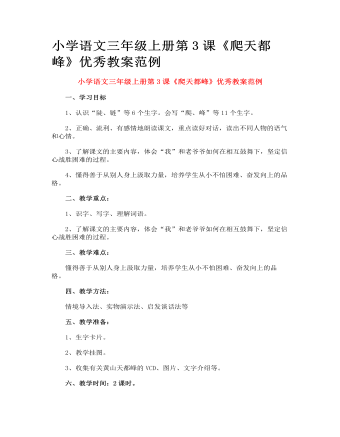
小学语文三年级上册第3课《爬天都峰》优秀教案范例
深入读议,体会“我”受鼓舞爬上峰顶 1、在爬山之前,望着又高又陡的天都峰,“我”心里是怎么想的?默读课文,圈点勾画,想想从哪些词语、句子中看出“我”有害怕畏惧的心理。 指名交流,出示并指导读好问句“我爬得上去吗?”、感叹句“真叫人发颤!”以及语气词“啊”“哩”等,读中体会“我”缺乏自信、畏惧退缩的心理。 2、结果“我”爬上峰顶了吗?自由读课文的第8至10自然段,出示“我”说的话,指名朗读。 3、“我”看到了什么从而下定决心爬上峰顶呢?自由读课文第3到7自然段,想想我的心理发生了怎样的变化。 a. 出示第4段重点句,引导学生深入讨论交流,从中感受到“我”受老爷爷爬山鼓励而下定决心爬上峰顶的内心活动。 b. 体会“我”的心理,指导朗读3、4自然段。 4、“我”是怎么爬的?自由读6、7自然段,画出描写爬山动作的词语。 a. 学生读书圈划。 b.学生交流。引导学生联系上下文,体会“奋力”是拼尽全身力气的意思。 从“攀着铁链”、“手脚并用向上爬”可以看出爬山的艰难。 c.引读第7段,从“终于”二字上体会爬得辛苦、上山后的喜悦。 d. 体会爬山的艰难、上山后的喜悦,指导朗读6、7两段。
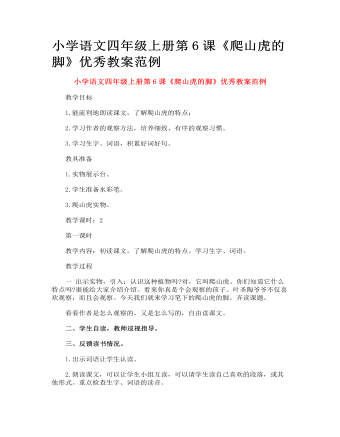
小学语文四年级上册第6课《爬山虎的脚》优秀教案范例
请同学们看实物。 1.你看到了什么? 2.有什么特点? 3.你能用一两句话把这些特点连起来说说吗? 4.叶圣陶爷爷笔下的爬山虎的叶子怎样呢?自由朗读第二自然段。 5.读了有什么感受?(美)哪些地方写的美?你喜欢哪句? 6.自己感受一下风吹时爬山虎叶子的美。做一做拂过、漾起的动作,你能读好这句话吗?想欣赏一下风吹爬山虎的样子吗? 7.老师指导读出美来。可以采取老师读前半句,学生补充后半句的读法,也可以男女生分组读,让学生充分感受爬山虎叶子的美。 8.作者为什么把叶子写的这么美呢?(认真观察)所以我们要学习作者认真仔细地观察事物的方法,养成良好的观察习惯。 爬山虎的叶子之所以生机勃勃地铺满墙,这跟它的脚有密切的联系,爬山虎的脚又是什么样的呢?
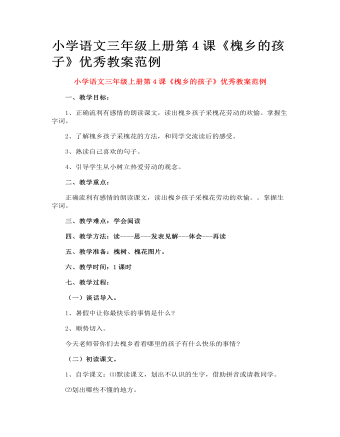
小学语文三年级上册第4课《槐乡的孩子》优秀教案范例
课堂上把重点放在了让学生在读的过程中体会出槐乡孩子的懂事、吃苦耐劳和以苦为乐的特点,因为是略读课文,所以我就只提了一个问题,槐乡的孩子与我们有什么不同呢?让学生通过各种方式的读说自己读了课文后的的体会。学生在回答时,大都抓住了“勤劳的槐乡孩子是不向爸爸妈妈伸手要钱的,他们上学的钱是用槐米换来的.”及槐乡孩子的勤劳,对此学生感受最深,槐乡孩子以苦为乐的精神,是靠我点出来了,当时有部分学生说第三段写的槐乡孩子干活时的样子写得很好,当时天很热他们还在干活.我就趁机引导学生朗读体会当时天气的热,又读一读描写干活时的句子,学生体会到孩子们劳动时是很快乐的。学生已经能够通过读文理解文中的内涵,但总结的能力不行,大都是只看到点,看不到面。反思本节课,虽然课文都是由学生具体读,但都是我直接参与指导方法等,是我一步步引着走的,属于半放半扶。下次的略读课我打算完全放手,由各学习小组的组长和学生一起学习。

XX学年第一学期期中考试动员国旗下讲话稿:积极复习,有效迎考
敬爱的老师、亲爱的同学们:大家早上好!我是九(5)班的林xx,今天我国旗下讲话的题目是积极复习,有效迎考。时间过的真快,一晃半个学期即将过去,马上就将迎来期中考试了。期中考试不仅是对同学们半个学期以来学业成果的一次盘点、检阅,更是对同学们的自信心、自觉性、意志力、诚信度的一次考验。也是对老师们辛勤工作的最好回报。勤奋出天才,这是一面永不褪色的旗帜。它永远激励着我们不断地追求,不断地探索。每个人都应该学会手脑并用,把烂笔头和聪明大脑结合起来,刻苦学习,一心向上。只有积极复习,有效迎考方能取得好成绩。在复习阶段,我们要温故知新、查漏补缺,把所有的作业本和测试卷都整理出来,找出原来的错题,进行归纳总结,分析错误的原因,吸取经验教训,再做一些同类的题目进行巩固,并学会一题多解,举一反三。



